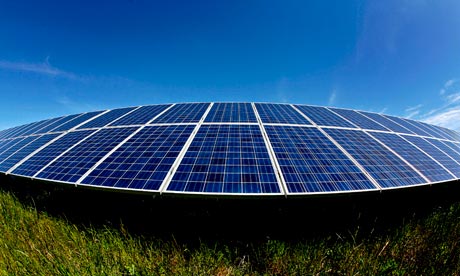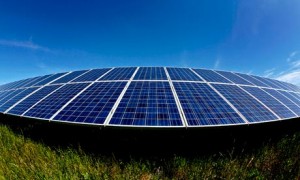The fledgling boom in solar power across the UK is in danger of being snuffed out, the renewable energy industry has warned, as ministers have determined to stick by spending plans that would severely limit future investment in the power source.
Almost all of next year’s budget for feed-in tariffs – a subsidy paid to generators of solar power and other forms of small-scale renewable energy – is already “spoken for”, because it will have to be allocated to existing solar installations, according to Dave Sowden, chief of the Micropower Council, the trade body for the sector. Once the renewable energy equipment has been installed, the owner is entitled to feed-in tariffs for as long as it generates electricity, unless the government changes the rules in future.

As most of the allocated budget, running to £161m next year, will go to owners who installed equipment this year, that will mean much less money available for new small-scale renewable electricity installations next year and in subsequent years up to 2015, when the current government spending period is due to end.
The prospective funding drought has become a serious worry for renewable energy companies, Sowden said.
“The scheme is a victim of its own success,” said Sowden. “If the annual caps are as rigid as we are being led to believe, this is a serious problem. The industry is worried that the growth is not going to be there.”
Owing to the unexpected success of the scheme, the money could start to run out more quickly than ministers had envisaged. This could effectively put a brake on the growth of the fledgling solar industry, which has already been rocked by changes to the feed-in tariffs that will disadvantage bigger installations.
The Department of Energy and Climate Change (DECC) said: “The scheme is paid for by energy consumers through their bills and has a fixed budget. The scheme is proving popular with households and we are continually monitoring the take up to make sure that we stick to budget. As we have previously said, all tariffs in the scheme are being considered in the comprehensive review with that in mind and we are monitoring the situation very closely.”
Sowden suggested that the government could increase the amount available to microgeneration by reallocating money from the Renewable Obligation scheme, which provides a subsidy to large-scale generators of renewable energy, such as wind farms. That money – about £2.3bn is expected to be the budget next year – is likely to be under-spent, as electricity companies struggle to gain planning permission for wind farms and other large-scale projects.
However, the government appears reluctant to reallocate budgets. DECC said: “The obligation is set as a number of renewable obligation certificates (ROC) per MWh supplied, so the total cost to consumer will depend on demand levels. The RO operates on a financial year basis, so we will know how many ROCs were issued, and how much electricity was supplied for the current year, after 31 March 2012.”
Feed-in tariffs have proved immensely popular, as they give householders and businesses a guaranteed income stream from renewable energy, as well as providing them with free electricity. An average installation costing about £12,000 could be expected to generate about £1,000 to £1,200 a year, which means a bigger return than most financial investments can provide.
From April 2010 to the end of June this year, more than 160MW of low carbon electricity generation was put in place under the feed-in tariff scheme, with a total of 44,460 separate installations, most of them solar panels fitted to houses.
The government has budgeted for £161m to be spent on feed-in tariffs in 2012-13. As it was originally envisaged, the feed-in tariff scheme – the money for which does not come from taxation but from energy companies, who recoup the money by adding to electricity bills – would not have been subject to a cap. However, the Treasury under George Osborne insisted that the money for the scheme be subject to government cost controls. Ministers have also acknowledged they were concerned at the idea that electricity consumers could face bill rises in the future, and determined that the scheme should be capped at £860m between 2011 and 2015.
According to the budgets, £269m should be available in 2013-14 and £357m the following year. The increases are to take account of the fact that existing installations will continue to benefit, even as new generating capacity is added.
Around the UK, in the first 15 months to 30 June 2011, more than 160MW of low-carbon electricity generation has been applied for under the feed-in tariff scheme, with a total of 44,460 separate installations, according to data collated by the electricity regulator Ofgem and the Department of Energy and Climate Change. About three quarters of the installations are solar power, though in Scotland wind is predominant.
AEA, an energy and environmental consultancy, has calculated the rate of growth in capacity in microgeneration at about 400% since the feed-in tariff was launched in April 2010. Photovoltaic technology – solar panels – have been at the forefront, with an increase in generating capacity of about 900%, though part of this was owing to the pent-up demand as households delayed putting up panels until the feed-in tariffs came into force. Over the same period, wind generation and hydro electricity – some smaller installations of which also qualify for the enhanced feed-in tariffs – have also grown strongly.

 Follow
Follow